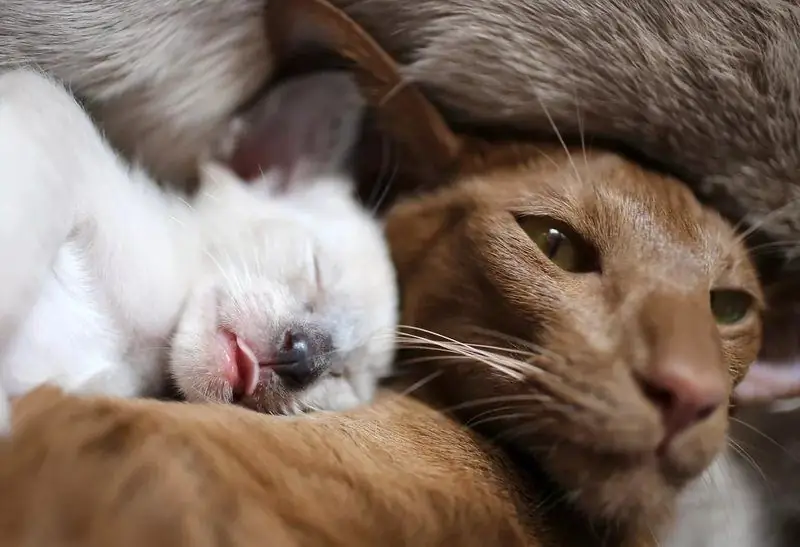
Table of contents:
- Author Bailey Albertson [email protected].
- Public 2024-01-17 22:26.
- Last modified 2025-06-01 07:32.
Mastitis in a cat: how to help a pet

The onset of mastitis can suddenly disrupt the happy expectation of a cat's offspring or darken her motherhood. Pathology can occur even in a sterilized pet, puzzling its owner a lot. The ability to recognize in time and also prevent mastitis will help in most cases to avoid both the disease itself and its severe complications.
Content
- 1 What is mastitis
-
2 Causes of pathology
- 2.1 Contributing factors
- 2.2 Video: Mastitis in Pets
-
3 How does mastitis manifest in cats
-
3.1 Forms of mastitis
1 Photo Gallery: Mastitis in Cats
- 3.2 Diagnosis of mastitis
-
- 4 When an urgent visit to the veterinarian is necessary
-
5 Treatment of mastitis at home
- 5.1 Video: massage of the mammary glands with lactostasis in a cat
- 5.2 Pet first aid
- 5.3 Treatment depending on the form of the disease
-
5.4 Table: Medications Used to Treat Feline Mastitis
5.4.1 Photo Gallery: Medicines for Feline Mastitis
- 5.5 Folk remedies effective for mastitis in cats
-
5.6 How to carry out treatment procedures
5.6.1 Video: Using a Homemade Breast Pump
- 5.7 Taking care of a sick cat
- 5.8 Features of the course and therapy of mastitis in pregnant cats
- 6 Prevention of mastitis
- 7 Recommendations from veterinarians
What is mastitis
Mastitis is an inflammation of the mammary gland that occurs in all mammals, including cats.
Mastitis in most cases is caused by bacterial flora, especially pyogenic staphylococci and streptococci, as well as their associations with other types of bacteria. Less often, the cause of the pathology may be fungal flora.
Mastitis is usually divided into:
- Lactation. They arise during the active functioning of the gland and are associated with milk production. They are characterized by the rapid development of the infectious process with the involvement of new sites; there is also a risk of generalization and the development of septic complications. This is due to the fact that during lactation the mammary gland has a large number of natural cavities filled with milk and surrounded by fatty tissue, this is an attractive substrate for bacteria. An extensive network of milk ducts and lymph vessels creates good conditions for the rapid spread of microbial flora. The onset of lactation mastitis is preceded by lactostasis - with insufficient or untimely emptying of the gland, an increase in the number of microbial flora occurs, which is normally washed out of the ducts. The bacteria fermentas a result of which milk is curtailed, and the epithelium of the excretory ducts of the gland is damaged. Curdled milk and desquamated epithelium form clots that block the milk ducts, impede milk flow and create a fertile ground for the development of mastitis. In parallel with the multiplication of microbes, stagnation begins in the lymphatic vessels and veins, since their thin walls are compressed by increasing edema, which further contributes to the development of infection. The lactational form of mastitis is the most common. In parallel with the multiplication of microbes, stagnation begins in the lymphatic vessels and veins, since their thin walls are compressed by increasing edema, which further contributes to the development of infection. The lactational form of mastitis is the most common. In parallel with the multiplication of microbes, stagnation begins in the lymphatic vessels and veins, since their thin walls are compressed by increasing edema, which further contributes to the development of infection. The lactational form of mastitis is the most common.
- Non-lactation. They develop as complications of trauma to the gland or pustular infection of the skin against the background of an immunodeficiency state. In this case, the glandular tissue is involved in the inflammatory process for the second time, being affected by an infection that has passed from adjacent areas. The course of non-lactation mastitis is less violent, but they predispose to the onset of mastitis during lactation, both due to changes in the anatomical structure of the gland, and due to the possible preservation of areas of inflammation and microbial flora in its tissues and ducts.

Mastitis most commonly affects lactating cats
Causes of pathology
The causes of mastitis are:
- injuries to the nipples and mammary glands, burns, frostbite;
- diseases of the reproductive system;
-
complications during the postpartum period:
- endometritis - inflammation of the lining of the uterus;
- pyometra - accumulation of purulent exudate in the uterine cavity;
- microtrauma of the nipples;
-
the presence of hormonal imbalance:
- false pregnancy;
- taking hormonal drugs to prevent estrus;
- "Empty" heat;
-
stagnation of milk in the mammary glands:
- excess milk production;
- few kittens who do not have time to consume milk;
- early weaning of kittens;
-
improper care of a lactating cat:
- keeping in a cold room;
- poor hygiene leading to contamination of the nipples;
- the transition of the inflammatory process to the mammary gland from another source, for example, from an adjacent purulent wound.

Taking hormonal drugs to suppress sexual behavior can cause mastitis
Predisposing factors
The predisposing factors for the development of mastitis are:
- heredity - a tendency to inflammation of the mammary glands can be inherited;
- immunodeficiency conditions, for example, helminthic invasions;
- unbalanced cat nutrition;
- the presence of foci of chronic infection;
- previously transferred mastitis;
- the first pregnancy in a cat - during the first, especially early pregnancies, the mammary gland may not have time to complete its formation;
- concomitant diseases, such as diabetes or obesity;
- mastopathy.
Thus, mastitis can occur in nulliparous cats as a result of hormonal therapy or false pregnancy; it can even occur in a spayed pet if she was left with ovaries during the operation.
Video: mastitis in pets
How does mastitis manifest in cats?
Signs of developed mastitis in a cat will be:
- an increase in inflamed glands;
- their pain on palpation;
- local increase in skin temperature above them;
- redness of the nipple and skin covering the mammary gland;
- fever;
- lethargy, general depression;
- avoiding kittens;
- anxiety in kittens caused by underfeeding or gastrointestinal upset when consuming infected milk;
- a decrease in the rate of weight gain in kittens;
- a change in the nature of milk secreted from the affected gland - it contains clots of milk protein - casein, formed when milk is curdled, changes color - becomes bluish and watery, contains pathological impurities due to the content of inflammatory exudate.
Forms of mastitis
Depending on the nature of the inflammation in the mammary gland, veterinarians subdivide mastitis into the following forms:
- Catarrhal. On palpation of the gland, small painless nodules are determined, which may disappear after expressing milk or applying the kitten to the nipple. Changes in the general condition of the cat, no increase in temperature yet. The leading role in the development of this condition belongs to lactostasis.
- Serous. The diseased gland increases in size and looks swollen, thickened, tenderness on palpation is weak. The temperature of the skin over the gland rises. When expressing, an initial separation of a clear aqueous liquid occurs, followed by milk, in which flakes are determined. At this stage of inflammation, lactostasis is aggravated by edema of the breast tissue. If help is not provided, the infection develops further, and the type of inflammation will depend on the nature of the pathogen.
- Fibrinous. It is characterized by the deposition of fibrin films inside the glandular tissue, as well as in the milk ducts. The affected gland is enlarged, compacted, its palpation is painful. On palpation, crepitus is determined - a slight crunching that appears when the fibrin films are destroyed. There is an increase in regional lymph nodes, the body temperature rises, the amount of milk to be separated decreases, it has a watery character and contains crumbs of casein and fibrin films.
- Hemorrhagic. The affected gland and the skin covering it are covered with hemorrhages; the gland is edematous, enlarged, painful on palpation. Milk is watery, reddish in color, contains protein flakes and blood clots. The cat has a fever, a violation of the general well-being.
- Purulent. The diseased gland is enlarged, edematous, covered with bright red skin. Palpation is sharply painful. There is a cloudy purulent discharge from the nipples with an unpleasant odor. Regional lymph nodes are enlarged and painful. The general condition of the cat suffers greatly - high fever, general depression, severe pain syndrome.
- Absolute. It is a complication of the purulent form of mastitis, when purulent exudate melts the tissue and inside the gland, pus-filled cavities - abscesses - form. It is accompanied by high fever, intoxication.
- Phlegmonous. It is also a complication of purulent mastitis, while the breast tissue melts, a diffuse focus of purulent inflammation is formed.
- Gangrenous. It can be a continuation of the purulent form of mastitis, and is also caused by anaerobic flora. It is characterized by necrosis and decay of the soft tissues of the mammary gland, fetid purulent discharge, the transition of inflammation to the surrounding tissues - muscles, skin, subcutaneous tissue. The general condition of the cat is extremely difficult, the body temperature can be either very high or low, the cat is motionless, breathing is shallow, blood pressure is low, the pulse is rapid. Regional lymph nodes are sharply enlarged. The formation of remote septic foci can occur - in the liver, kidneys, spleen, and brain.
Mastitis can affect both one mammary gland and several at once, and the cat's condition worsens in proportion to the number of affected glands.
Cats most often have catarrhal, serous and purulent forms of mastitis. Hemorrhagic and fibrinous forms are rare, they are often accompanied by subsequent suppuration. Usually, hemorrhagic and fibrinous forms occur immediately after childbirth against the background of existing septic postpartum complications, for example, endometritis or unseparated placenta.
Absolute, phlegmonous and gangrenous forms of mastitis are destructive, as they lead to destruction of the gland tissue, irreversible loss of its function, are characterized by powerful intoxication and pose a threat to the cat's life.
In some cases, mastitis can be latent, while the cat's well-being, the appearance of the mammary glands and milk remain normal, but the kittens have gastrointestinal disorders. In this case, you need to take the cat's milk for research, including bacteriological, to a veterinary clinic, and you can also test the milk yourself: conditionally number the cat's nipples and take 8 numbered tubes, according to the number of nipples. Milk is decanted into each tube from one teat and left in the refrigerator for 12 hours. The appearance of even a mild sediment in the test tube indicates mastitis in the mammary gland from which the sample was taken.
Photo gallery: mastitis in cats
-

Mastitis in a cat sitting on the floor - Mastitis of the first pair of mammary glands is quite common: they are the least attractive to kittens, so milk can stagnate in them
-

Serous mastitis in a cat - Serous mastitis can be treated at home
-

Purulent mastitis in a cat lying on the floor - With the development of a purulent form of mastitis, the help of a veterinarian is needed
Diagnosis of mastitis
Diagnosis of mastitis is usually straightforward, and the diagnosis is based on physical examination findings. The type and scope of therapy differ for different forms of mastitis, and therefore it is important to correctly establish the form of the disease.
When you need an urgent visit to the veterinarian
Unfortunately, it is far from always possible to catch mastitis at an early stage, and in the overwhelming majority of cases this is due to the rapid development of the inflammatory process, as well as the fact that many lactating cats do not allow inspection of their abdomen and mammary glands.
An urgent appeal to the clinic is necessary for:
- increased body temperature of the cat;
-
the appearance of signs of intoxication:
- lethargy;
- thirst;
- lack of appetite;
- general oppression, apathy;
- a significant increase in the size of the mammary gland, pronounced edema, when both the tissue of the organ and the nipple become dense to the touch;
- severe pain when feeling the gland;
- difficulties in expressing milk - milk does not leave or leaves slightly;
- the appearance of pathological impurities in milk - blood, pus, fibrin films;
- defeat of a large number of mammary glands;
-
the appearance of mastitis outside the lactation period, since in this case it:
- is a surgical pathology;
- may be a symptom of another medical condition.

With an increase in temperature and a violation of the cat's well-being, self-medication is unacceptable
Home treatment for mastitis
Self-treatment of mastitis at home can only be carried out by an experienced cat owner in the initial stages of the disease, which include catarrhal and serous forms. Signs that indicate the possibility of self-treatment for mastitis:
- lack of fever;
- pain on palpation of the gland is absent or mild;
- milk is separated freely when expressed;
- the increase in the size of the mammary gland due to edema is moderate;
- mastitis covers a small number of mammary glands.
Video: massage of the mammary glands with lactostasis in a cat
First aid for a pet
Before consulting a veterinarian, you should:
- provide the cat with peace;
- restrict access to water to reduce milk production;
- bandage the mammary glands with an elastic bandage;
- organize artificial feeding of kittens, if necessary.
In no case should the inflamed mammary glands be heated - this will accelerate the spread of the microbial process and worsen the cat's condition. Do not put kittens on sore nipples - infected milk is dangerous for them.
Treatment depending on the form of the disease
Treatment of the initial forms of mastitis, serous and catarrhal, is carried out by the owner of the cat at home:
- massage of the mammary glands;
- pumping milk from inflamed glands, softening of the seals is a criterion of effectiveness;
- sealing the nipple of the inflamed gland or bandaging it to make it inaccessible to kittens;
- limiting the drinking regime of the cat until the appearance of positive dynamics from the therapy;
-
application of external agents to the mammary gland:
- camphor oil;
- ichthyol ointment;
- Levomekol;
- Iruksovetina;
- Mastieta-Forte.

To restrict access of kittens to the nipples, as well as to prevent the cat itself from licking them, a blanket is put on it
If it was not possible to achieve positive dynamics and signs of purulent inflammation appeared, then the treatment is carried out exclusively by a veterinarian using:
-
broad-spectrum antibacterial drugs:
- Sinuloxa;
- Claforan;
- Kefzola;
-
sulfa drugs:
- sulfadimethoxine;
- sulfalene;
-
antihistamines:
- Tavegila;
- Suprastin;
- analgesics (Loxicoma);
-
veterinary homeopathic remedies:
- Mastometrin;
- Trauma gel;
- fortifying agents (Catosala);
-
immunomodulators:
- Gamavita;
- Fosprenil.
With destructive forms of mastitis (abscessed, phlegmonous and gangrenous), surgical treatment is performed under anesthesia for emergency indications:
- An autopsy is performed on the abscesses.
- Purulent contents are removed.
- The wound is washed with antiseptic solutions.
- Drainage tubes are left for the outflow of wound discharge.
- If non-viable tissues are found, they are removed.
In the future, dressings are carried out using:
- 3% hydrogen peroxide solution;
- 1-2% aqueous chlorhexidine solution;
- ointment Levomekol.
Table: Medications Used to Treat Feline Mastitis
| A drug | Structure | Operating principle | Price, rubles |
| Sinulox |
|
Broad-spectrum antibacterial drug | 910 for 40 ml |
| Claforan | Cefotaxime | 100 per 1 g | |
| Sulfadimethoxine | Sulfadimethoxine | Broad spectrum antimicrobial agent, can be combined with antibiotics | twenty |
| Tavegil | Clemastine | Desensitizing drug (antiallergic); causes drowsiness. Contraindicated in pregnancy and lactation. | from 154 |
| Loxicom | Meloxicam | Pain reliever. It is not used during pregnancy, lactation, as well as in cats with gastrointestinal ulcers and gastrointestinal bleeding. | 780 for 15 ml |
| Catosal |
|
May be used during pregnancy and lactation. |
995 for 100 ml |
| Gamavit |
|
Immunomodulator, increases the bactericidal properties of blood serum, increases resistance to adverse factors | from 178 for 10 ml |
| Levomekol |
|
Has antimicrobial and anti-inflammatory effect, helps to cleanse purulent wounds | from 102 |
Photo gallery: medications for mastitis in cats
-

Sinulox - Sinulox is effective in treating feline mastitis
-

Gamavit - Gamavit enhances the bactericidal properties of blood serum and promotes recovery
-

Loxicom - Loxicom will be needed for pain relief in destructive forms of mastitis
-

Catosal - Catosal improves metabolism and stimulates healing processes
Folk remedies that are effective for mastitis in cats
Traditional medicines are used to treat mastitis exclusively as part of complex therapy and are not effective enough to be used in isolation. For the treatment of mastitis are used:
-
Decoction of oak bark. It is used to wipe the mammary glands, as well as for compresses. It has anti-inflammatory, anti-putrefactive, hemostatic effect:
- Pour boiling water over 1 tablespoon of chopped dry oak bark.
- Boil for 20 minutes.
- Cool down.
- Strain and use for wiping the mammary glands when caring for them, as well as for compresses.
-
Infusion of chamomile pharmacy. Has antiseptic and anti-inflammatory effects:
- Pour a tablespoon of chamomile flowers with a glass of boiling water.
- Soak for half an hour in a water bath.
- Cool down.
- Filter.
- Add 4 g of boric acid, use for compresses and rubbing the mammary glands.
-
Pharmaceutical sage - can be used as a local remedy for inflamed glands, as well as to reduce lactation when taken orally:
-
For topical use (has a pronounced antimicrobial effect) used in the form of an infusion:
- Pour a tablespoon of sage with a glass of boiling water.
- Insist 20 minutes.
- Cool down.
- Filter and use for compresses and lavatory of the mammary glands.
-
For oral administration (helps to reduce lactation):
- Put 25 g of sage leaves in a porcelain teapot.
- Pour 0.5 liters of boiling water.
-
Insist half an hour. Drink for several days to reduce lactation.

Sage Sage is used in the form of an infusion for mastitis as a means for compresses, and for oral administration - to reduce milk formation
-
- Cabbage leaves (reduce inflammation) - a fresh cabbage leaf is lightly beaten or rolled with a rolling pin, then applied to the mammary glands for 3 hours.
How to carry out medical procedures
Treatment for a cat depends on the form of mastitis:
- The nipples are bandaged with an elastic bandage or sealed, making them inaccessible to kittens.
- They carry out a regular toilet of the mammary glands using herbal infusions.
- Massage the affected mammary glands with gentle stroking movements, as well as expressing milk. You can express milk either by hand or using a homemade breast pump - for this, the distal part (with a needle attachment) should be cut off from a 20 ml plastic syringe, and then the edges should be melted using a candle or a lighter to make them smooth. Applying it to the areola area, slowly and carefully pull the piston toward you. The milk is expressed as it arrives, usually 5-6 times a day.
- After pumping, an ointment is applied, the inflamed glands are closed with napkins and fixed with an elastic bandage. You can put on a blanket on top. If the cat is trying to get to the nipples, a protective collar is used.
- If antibiotics or other drugs are prescribed, they are administered according to the scheme prescribed by the veterinarian.
- If surgical treatment has been carried out, then the wounds are bandaged with antiseptic solutions and Levomekol ointment. After the wounds are cleared of pus and healing begins, dressings are carried out every two days with Solcoseryl ointment.
Video: using a homemade breast pump
Taking care of a sick cat
The following steps are taken to care for your cat:
- the cat is placed in a warm place;
- provide the pet with peace, absence of stress;
- with serous and catarrhal forms of mastitis, breastfeeding is continued, gluing the nipples of the affected glands from the kittens; if antibacterial therapy is carried out, then the kittens are fed artificially;
- it is preferable to use dry food in feeding;
-
limit the drinking regimen until positive dynamics in the treatment of mastitis is achieved:
- if the cat eats dry food, then they give just enough water to wash it down;
- if the cat is on a natural diet, then water is given once a day in the amount in which she can drink;
- ensure the cleanliness of the elastic bandages, as well as the blankets used on the cat (the blanket is regularly washed and ironed, the elastic bandages are washed or replaced).
Features of the course and therapy of mastitis in pregnant cats
During pregnancy, both lactational mastitis, caused by hormonal disruption and premature onset of milk production, and non-lactational mastitis, arising against the background of physiological immunodeficiency that is present during pregnancy, can occur; trauma can be a provoking factor.
In all cases of mastitis, or even suspicion of it, the animal should be consulted by a veterinarian, since it is important to prevent the development of a complicated form of mastitis in a pregnant cat. In the treatment of the initial forms of mastitis in pregnant cats, preference is given to drugs for local exposure and methods of traditional medicine, caring for the cat is of great importance. With the development of purulent forms of mastitis, the veterinarian will be forced to prescribe antibiotic therapy in the interests of the cat, usually amoxicillin and cephalosporins of 1-2 generations, as well as to carry out surgical treatment. If mastitis is lactational, it is important to express milk in a timely manner before kittens are born.
Prevention of mastitis
To prevent mastitis, the following measures are taken:
-
good conditions for keeping pregnant and lactating cats:
- purity;
- warm room;
- full feeding;
- lack of stress;
- timely treatment from external parasites;
- timely reception of anthelmintics;
- identification and treatment of concomitant diseases, especially postpartum complications;
- daily monitoring of the condition of the mammary glands and the appearance of milk;
- daily toilet of the mammary glands;
- protection of the mammary glands from damage (shorten the claws of kittens that have reached 2 weeks of age every week, if damage to the nipples appears, use healing agents, for example, sea buckthorn oil);
- elimination of hormonal agents for the relief of sexual behavior in cats;
- when choosing a method of sterilizing a cat, give preference to ovariohysterectomy surgery - when both the uterus and ovaries are removed;
- feeding kittens by a cat up to 2-3 months, in order to prevent excess milk.
Veterinarian recommendations
Mastitis is an inflammation of the breast. The disease can be associated with lactation, as well as occur separately from it. Lactational mastitis occurs most frequently in breastfeeding cats and is associated with milk stagnation. The initial stages of lactational mastitis can be treated at home, and it is very important to allow lactostasis. Non-lactation mastitis is a surgical condition and should be treated by a veterinarian surgeon. The emergence of destructive forms of mastitis requires surgical treatment for emergency indications.
Recommended:
Cystitis In Cats And Cats: Symptoms (blood In Urine And Others) And Treatment At Home, Medications (pills And Others), Veterinarian Advice
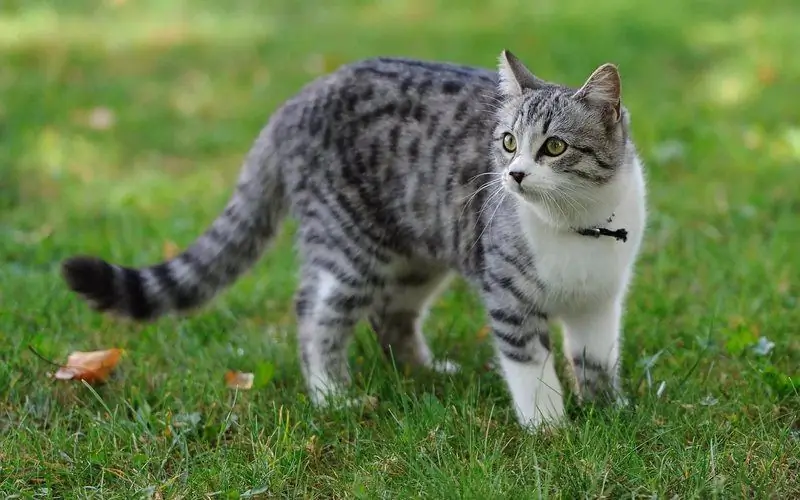
What causes cystitis, its symptoms, course forms, diagnosis, treatment. Caring for a sick cat, prevention of cystitis
One Or Both Eyes Of A Cat Or Cat Are Watering: Why, What To Do And How To Treat A Kitten And An Adult Animal At Home
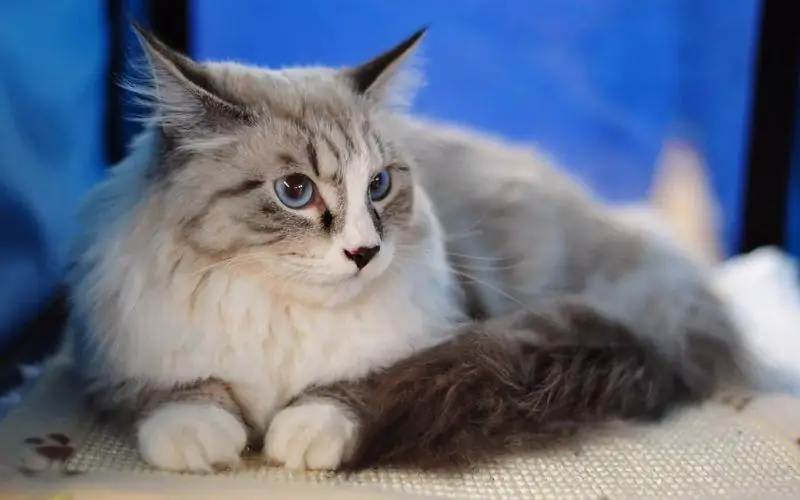
Lachrymation in cats looks like it is formed. Causes of lacrimation in a healthy and sick pet, breed predisposition. Prevention
Blood In The Feces Of A Cat Or Cat: Causes (including When The Kitten Cries) And Treatment, Expert Recommendations
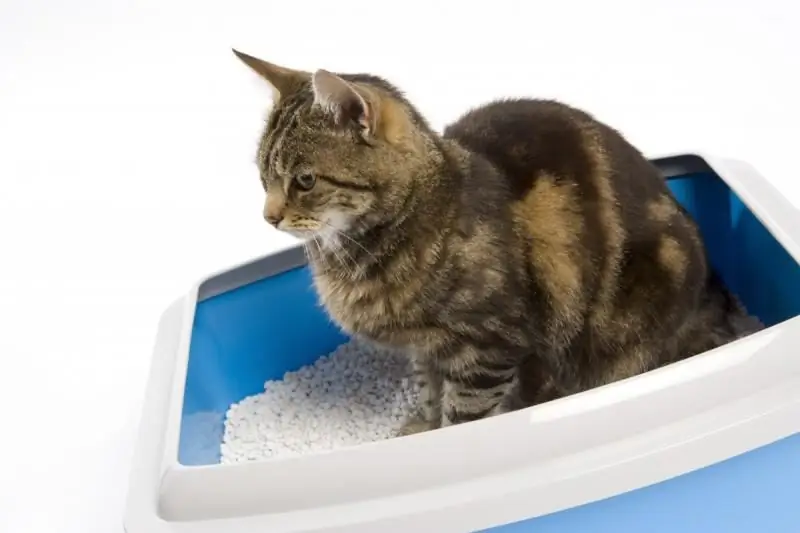
Blood in the stool in cats: what it looks like, with what diseases it occurs. What to do when detected. Methods for establishing the disease. When a doctor is urgently needed
Stomatitis In Cats (gangrenous And Others): Symptoms And Treatment At Home, Effective Drugs, Prevention

What is stomatitis in cats, its causes. Course types, symptoms. When to see your veterinarian. How to heal at home. Disease prevention. Recommendations
Cat's Or Cat's Eyes Fester: Reasons For What To Do And How To Treat A Kitten And An Adult Animal At Home, How To Wash It Out Of Pus
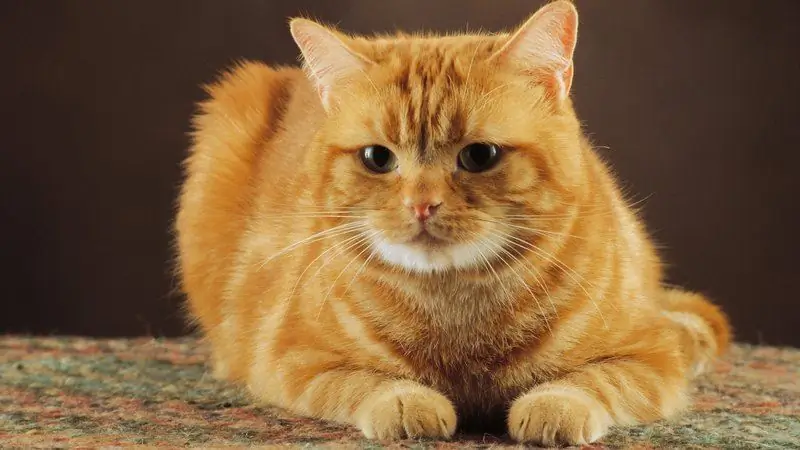
What does purulent discharge from the eyes look like in cats? For what diseases does the symptom occur? How is it treated. Care recommendations. Preventive measures
